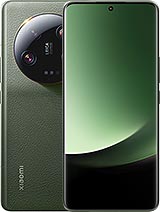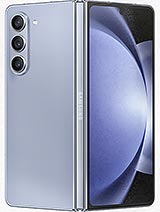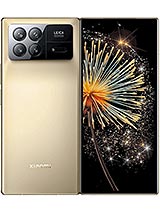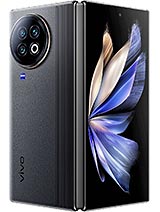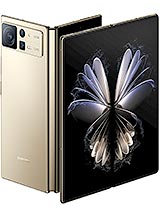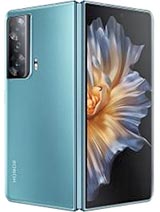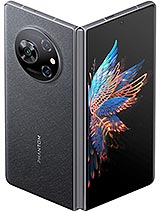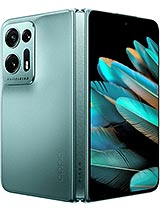Xiaomi Mix Fold 3 review

Android 13 with MIUI Fold 14.1.5
The Mix Fold 3 is running MIUI Fold 14.1.5, a foldable-specific version of Xiaomi's overlay, on top of an Android 13 core. The device is a China-only release, so it's on the Chinese branch of MIUI and we're not expecting an official global ROM.

That doesn't mean you don't get to use Google apps, it just means that you'll need to install them yourself, while the Play Services do come pre-installed. Also pre-installed is a wide array of Chinese apps, most of which you can thankfully uninstall.
Either way, you start off with the in-house browser and the default keyboard with the usual Chinese input capabilities and all of that is difficult to operate from a Western user's standpoint. Once you get Gboard, Chrome and the Play Store up and running, things get a lot smoother.
Still, there will be remains of Chinese elements here or there in the UI or in the system apps. Plus, we can't be certain if one or another software peculiarity wouldn't become an issue in the long run for more niche use cases.

Then there's the fact that some things in the UI and feature set are just different and that we find odd. For example, in some system apps (like the Clock) where the global MIUI builds use icons for different tabs, the Chinese build has simple text labels. The File Manager has that difference too, plus a different look of the Recent tab.
Next up, Xiaomi's own take on the Privacy Dashboard. Google released this privacy hub with Android 12, and different makers have been implementing it in their own ways, and Xiaomi itself has done it in two different ways depending on localization. Here the permissions are designated with icons, as opposed to the text labels in the global MIUI builds. Still, you get essentially the same functionality for keeping track of what app has used what permission when - it's just organized in a different way.






Clock • File Manager • File Manager • Privacy
It doesn't end there, naturally. We found no way to revert to a classic notification shade with quick toggles as the norm on most Androids - the Mix Fold 3 only has the two-pane option with notifications on the left and Control center on the right. Similarly, you don't get to choose the UI of the Recent apps - it's just the MIUI standard two-cards-per-row interface.



Notifications • Control Center • Recent apps
The homescreens would be familiar to a global Xiaomi user as well. You can choose whether to have an app drawer or not - that option has not been taken away. The leftmost pane is reserved for widgets only - it's not the Google Discover.






Lockscreen • Homescreen • Homescreen • App drawer • Widget pane • Settings
You unlock the screen via the side-mounted fingerprint scanner. It's always-on, fast and reliable, no complaints there. It can be set to trigger either on Press or on Touch. The latter may yield misreads due to its position, and that's why Xiaomi has set its default operation to be on Press.
Aside from the fingerprint reader, you can unlock the phone using 2D Face Unlock, but it is far less secure than the fingerprint option.






Biometric security • Fingerprint settings • Face unlock
MIUI comes with its proprietary multimedia apps - there's Gallery, and Music and Mi Video. And, of course, a Mi Remote app that uses the integrated IR blaster.
Then there's the Security app. It can scan your phone for malware, manage your blacklist, manage or restrict your data usage, configure battery behavior, and free up some RAM. It can also manage the permissions of your installed apps, define the battery behavior of selected apps, and apply restrictions only to certain apps.






Gallery • Music • Video • Mi Remote • Security
We'll reiterate that the division in design and functionality between Chinese and global MIUI builds perplexes us, but there could be some regional and cultural nuances that Xiaomi gets, and we don't. Just like the previous generation, you could seemingly use the Mix Fold 3 just fine outside of China, though you'll never be able to completely remove all references to Chinese apps and services, and some specific things may not work at all.
On to the main act, the Mix Fold 3's internal display and its 'tablet' mode implementation.
As before, the screen always shows two homescreen panes instead of just one. And the leftmost widget page from the default UI now pops up on top of the default homescreen. The larger display allows for a larger dock, which in addition to the up to six docked apps, also shows the three most recent ones.



Homescreens • Homescreens • Widget pane
The Notification shade gets pulled down from the left half of the status bar area, but drops down at the center of the display. The Control center, on the other hand, always takes the right part of the screen.


Notification center • Control Center
Some apps, like Settings, Notes, File Manager, make use of the larger screen by offering split-screen UI.



Settings • Notes • File Manager
There is a special 'Features for foldable devices' menu, which explains the things you can do on the foldable screen.
Floating windows and conversation bubbles is the first category. Floating Windows work in a familiar fashion - there is a Sidebar where you choose from a list of customizable apps. Once you tap on the app icon, it will launch within a floating window with full functionality.
Conversation bubbles from supported apps like Messages, Mail, and social networks are supported, too.
You can work with the floating app and move it around. You can also open it in full-screen, snap it on the left/right side to open split-screen view, or simply close it by swiping up on its bottom bar.
You can have up to two floating windows at the same time, and one or two apps in full-screen/split-screen mode opened in the background - this makes a total of four active apps on the screen.
The split-screen view is neat, but rather basic - you cannot change its size and it's always 50/50 with the border where the foldable display's crease is. A double tap on the border will switch the apps, but that's about all the customizeability you get.

The 'After folding' menu item deals with what the phone should do when you fold it in and gives you three options - conditionally continue the app on the cover screen if you swipe up within 6 seconds, continue the app without the need to swipe, or simply lock the phone when you fold it.
There's a section of the menu that lets you decide on a per-app basis how the app should treat the squarish screen - apps that have a nice split-screen interface work well in 'Parallel Windows mode, while older apps that run into trouble when faced with unusual aspects can get a forced 16:9, for example.
And finally, the last tab just explains how the default Baidu IME for MIUI keyboard is designed for this foldable device - with split-screen ergonomic UI, resizable, and with duplicate G and V letters for convenience. The duplicate G and V work with GBoard too, but only in landscape orientation, for some reason.
The hinge's ability to maintain arbitrary angles (hovering, Xiaomi calls it) allows the UI of some apps to switch to a foldable-only layout with the top half reserved for consumption and the bottom one for interaction. We found it to work with YouTube and the in-house video app. Netflix, for example, isn't optimized for it, but it does detect the folding and moves its entire interface into the 'hovering' half.
Some more foldable-related features show up when using the camera, but we'll talk about them later on in the review.
And that's about it. Overall, MIUI Fold doesn't strike us as particularly great at making use of the large screen - the split-screen functionality, for one, is rather limited. One UI does it better, we reckon.
Performance and benchmarks
Much like most of the large foldables this year (and most high-end smartphones altogether) the Mix Fold 3 is powered by the Snapdragon 8 Gen 2. Its octa-core processor features one prime core, four performance ones (further subdivided into 2+2), and three cores for less demanding applications, so it's a 1+2+2+3 setup. The Mix gets the higher clocked version of the prime core too - 1x3.36GHz Cortex-X3 + 2x2.8 GHz Cortex-A715 & 2x2.8GHz Cortex-A710 & 3x2.0GHz Cortex-A510 CPU cores.

The Gen 2 chipset offers 35% higher performance and 40% improved efficiency in the CPU department over the previous Gen and 25% and 45% performance and efficiency bumps on the GPU side of things (which goes by Adreno 740). It also has support for new, faster memory technologies (LPDDR5X and UFS 4.0). That's nice and all, but since you're likely comparing the latest phones to their equally latest rivals, those differences aren't all that important since most current top-tier devices have the same chip inside.
Just like the 13 Ultra, the Mix Fold 3 exists in three memory configurations - 12GB/256GB, 16GB/512GB (our review unit), and 16GB/1TB.
Our benchmark exploration starts with GeekBench as usual, where the Mix Fold is roughly on par with other SD 8 Gen 2 devices - no surprises here.
It's a similar story in Antutu as well, though the vivo is a bit of an overachiever here.
The Mix earns the 'overachiever' badge in the offscreen tests in GFXBench, where it tops the charts, even with somewhat of a significant margin in the less demanding titles.
The Xiaomi foldable continues to outperform the pack in the onscreen tests on the large display as well, most of the time posting figures about 10% higher than the Galaxy Z Fold5.
Running the onscreen tests on the cover display, the Mix Fold 3 inevitably surrenders the lead to the Galaxy Z Fold5 - the Samsung's lower resolution gives it an edge in frame rates.
In 3DMark's Wild Life test the Mix posted a higher-than-expected result, but things return to normal in Wild Life Extreme.
We also ran the usual stress tests on the Mix Fold 3 but we have no screenshots to show you, because the phone invariably overheated and shut down the apps. In the CPU throttling test that would happen around 20 minutes into it, while in the Wild Life Stress test in 3DMark it would last 11 to 13 loops.
We can try and gloss over those results with something along the lines of 'these are overly demanding synthetic tests that don't translate into real-life use' and that is true, but it's also true that other phones breeze through them, or at least complete them with some level of composure.
Reader comments
- Sly
- 05 Dec 2023
- pLG
Google Pay not works only when you have unlocked bootloader. When you back to stock rom or relock bootloader Google pay will be works.
- Kevin
- 03 Dec 2023
- pRD
Absolutely awesome mobile ...perfect value for money. Excellent customization options for lock and home screen. Video quality is amazing on open fold screen. Camera is an absolute tough competition to Samsung fold or One plus. I am in love w...
- simrag1970
- 20 Nov 2023
- 39x
I have been using the fold 3 since September 2023. It is overall a great phone.i can use Google wallet as normal and add all my cards. The main issue is that it doesn't show the new notifications like WhatsApp or messenger. I don't know wha...













